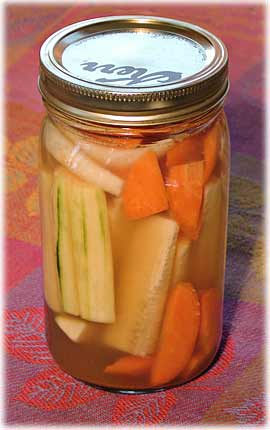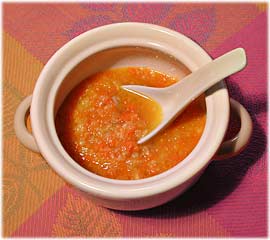 | |||
|
Our lives,
so seemingly small, ripple out to the whole universe as tiny whispers like the sounds of butterfly wings, and the clear voice of the living truth. -J.L.D. |

Several years ago I asked to be clearly shown the perfect diet for us. A few weeks later a vivid dream came in which I saw a huge wooden table, completely covered with an array of colorful vegetables, fruits, nuts, and seeds of all manner and variety. These foods were to become the basis for our rejuvenating diet, and a way of expressing love to ourselves by nourishing our bodies. The dream didn't say what to do, it just showed the food. The figuring out part has been our process of discovery.
One easy recipe to make that our friends love is raw pickles. We've found that marinating cucumbers in apple cider vinegar helps the cucumber to digest. In just a few hours we can enjoy eating the most delicious pickled veggies that add a savory bite to any meal.
 Raw Pickles
Makes one quart
1 cucumber (about 6-8 inches in length)1 carrot 1/4 sweet yellow onion 1 cup filtered or spring water 3/4 cup unpasteurized apple cider vinegar 1 teaspoon Himalayan or Celtic salt 2 teaspoons ground pickling spice (we use Frontier brand) Directions
Put vinegar, water, salt, and pickling spice into a 1 quart mason jar with lid.Rinse, and peel cucumber if necessary. Cut into 1/4 inch thick rounds or into long segments. Rinse, and scrub or peel carrot to remove any damaged spots. Cut diagonally into 1/4 inch thick pieces. Rinse onion, remove skin, and cut off a large chunk, about 1/4 of the onion. Slice into 1/4 inch pieces. Place all ingredients into mason jar. Tighten lid. Shake to distribute pickling spice. Let sit for at least three hours, or overnight, refrigerated. Alternate Recipe: Pickle Relish and/or Salad Dressing
Little Story — How We Stock Our Kitchen: A friend recently asked us to tell her what staples we usually have on hand and this became the list that follows. It doesn't include seasonal foods like watermelon or asparagus, that come and go.
If keeping this amount of food on hand seems like too much to do because of your lifestyle, then work with your intuition to see how to proceed. Perhaps begin with stocking up on a few kinds of nuts and seeds, so you can make yummy pie crusts, cookies, and nut/seed milks on the weekends. Add a few new varieties of greens to keep salads vital and interesting. Buy fresh spices, different oils, or some apple cider vinegar to use in making pickles and delectable, fresh, salad dressings.
Items like cabbage, beets, apples, carrots, celery, onions, store well in the fridge, so these don't need to be purchased as often. Fruits can ripen in big bowls on the kitchen counters, enhancing the space, emitting delicate aromas. Sweeteners and oils, vinegars, dates, dried fruits, nuts, and sprouting seeds are easy to store in cupboards.
For us, it took some time to find the right balance with how much fresh produce to buy with how much we could eat without waste. We rotate various types of greens so we don't get tired of having the same ones all the time. We try to get everything we can organic.
Veggies: lettuces (butter, romaine, red leaf, green leaf, etc.), spinach, collards, kale, chard, parsley, cilantro, beets, all the cabbages—red, green, and Napa, green onions, sweet yellow onions, zucchini, cucumber, delicata squash, carrots, celery, cauliflower, broccoli, nori sheets, arame seaweed (sweet, mild taste), garlic, and ginger root.
Fruits: avocados, apples, bananas, pears, mangos, strawberries, blueberries, lemons, limes, grapefruits, pineapple, tomatoes, sun dried tomatoes, raw olives. We get organic frozen fruits (mangoes!) for smoothies during the winter.
Nuts and Seeds: sesame seeds, almonds, pine nuts, cashews, hemp seed nuts, pistachios, macadamias, sunflower seeds, pumpkin seeds, dried coconut, raw carob powder, chia seeds.
Sprouts (from Sprout People): mung beans, garbanzo beans, lentils, fenugreek, oats, alfalfa, clover, and more. And from our grocery store, we get Lundburg Wehani rice (also available from Amazon).
Sweeteners: agave nectar, Medjool dates, honey (very occasional use), raisins.
Oils & Vinegar: olive oil, Spectrum walnut oil (this brand is incredibly mild), unpasteurized apple cider vinegar, balsamic vinegar, unseasoned brown rice vinegar.
Spices, Salt, Seasonings: Cinnamon, curry powder, cayenne, grilling seasoning, clove, nutmeg, pepper, sage, rosemary, thyme, vanilla, coriander, yellow mustard powder, Fines Herbs, Himalayan or Celtic salt, South River Miso, Namashoyu.
We'll close today with what David Wolfe wrote in Eating For Beauty, "Proper nutrition is an art. It is an art form. Every bite is a brush stroke. Every swallow is a new color. Each meal is a cloud or a tree or a flower—a piece of the beautiful painting that you are becoming... you are truly a work of art in progress."
Thanks for being with us today, and we hope to see you next week for our upcoming installment, The Little Sprout Farm!
 |
||










